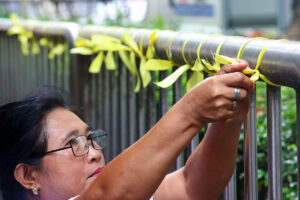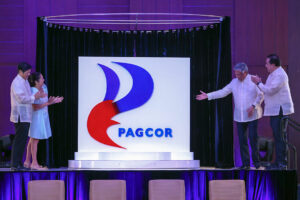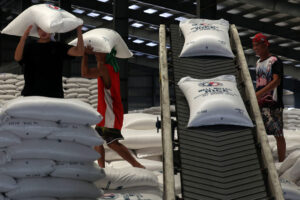Remembering the 1986 People Power Revolution

It was one of the most tense and terrifying times in our country. It was like the tremulous gloom of wartime, our elders said. February 1986 was turbulent and stressful.
Because he could no longer run for a third term as president in 1973, Ferdinand E. Marcos, Sr. issued Proclamation No. 1081 on Sept. 23, 1972, declaring Martial Law, using the civil unrest that arose after the 1969 Philippine balance of payments crisis as a justification for the proclamation. It was economics that started Marcos Sr.’s 14-year authoritarian regime. (Ferdinand Marcos and the Philippines: the political economy of authoritarianism, Greenwood Publishing Group).
“A major economic crisis in the early 1980s virtually drove the Philippine economy into a standstill, crippling businesses and sending millions of Filipinos out of their jobs and into the streets. That crisis, unique at a time when the rest of Southeast Asia was roaring ahead economically was the result of a crippling impact of the economy’s dependence on foreign debt which it could no longer afford to repay and the political instability caused by the popular outrage from the assassination of Benigno Aquino, Jr. in August 1983,” business and economics journalist Ping Galang recalled. “Private investors either moved out or froze operations. Marcos was left with no option but to call a ‘snap’ election to validate his mandate” (gmanetwork.com, Sept. 21, 2009).
The snap election was held on Feb. 7, 1986. The official election canvasser, the Commission on Elections (Comelec), declared that Marcos was the winner. The final tally of the Comelec had Marcos winning with 10,807,197 votes against rival candidate (assassinated hero Benigno S. Aquino, Jr.’s widow) Corazon Aquino’s 9,291,761 votes. On the other hand, based on returns of 70% of the precincts, the National Movement for Free Elections (Namfrel), an accredited poll watcher, had Aquino winning with 7,835,070 votes against Marcos’s 7,053,068 votes (iReport EDSA 20th Anniversary Special Issue | Dr. William Castro, Philippine Center for Investigative Journalism, February 2006).
Thirty Comelec computer technicians walked out while tallying the votes to protest the deliberate manipulation of the official election results to favor Ferdinand E. Marcos, Sr. The walkout was considered one of the early “sparks” of the People Power Revolution. The walkout also served as an affirmation to allegations of vote-buying, fraud, and tampering of election results by the KBL, Marcos’ political party (Ibid.).
On Feb. 13, Cebu Archbishop Ricardo Cardinal Vidal issued a declaration on behalf of the Philippine Church hierarchy stating that when “a government does not of itself freely correct the evil it has inflicted on the people then it is our serious moral obligation as a people to make it do so… Now is the time to speak up. Now is the time to repair the wrong. The wrong was systematically organized. So must its correction be. But as in the election itself, that depends fully on the people; on what they are willing and ready to do” (“Post-Election Statement” archived from the original by Wikipedia on Sept. 23, 2015).
On Feb. 16, 1986, Corazon Aquino held the “Tagumpay ng Bayan” (People’s Victory) rally at Luneta Park, announcing a civil disobedience campaign and calling for her supporters to boycott publications and companies which were associated with Marcos or any of his cronies. The event was attended by a crowd of about two million people (Schock, Kurt, 1999: “People Power and Political Opportunities: Social Movement Mobilization and Outcomes in the Philippines and Burma.” Social Problems). Other protest groups responded and unified to join Aquino’s call (“The road to EDSA” by Elfren S. Cruz, Philstar.com., retrieved by Wikipedia on May 18, 2021).
In the aftermath of the election and the revelations of irregularities, the Reform the Armed Forces Movement (RAM) — a group formed in 1982 consisting of officers of the Armed Forces of the Philippines (AFP) who were disgruntled by the patronage politics and corruption in the AFP — decided to mount a coup d’etat against Ferdinand Marcos (“The 3-Day Revolution: How Marcos Was Toppled” by Mark Fineman, Los Angeles Times, Feb. 27, 1986).
On Feb. 20, RAM approached Cory Aquino, informing her of the coup plans and that they would form a junta headed by a Council of Elders composed of Defense Secretary Juan Ponce Enrile, General Fidel Ramos, Jaime Cardinal Sin, businessman Jaime Ongpin, former executive secretary Alejandro Melchor, Jr., and former senator Salvador “Doy” Laurel. Mrs. Aquino rejected the offer, as there was a sense that the Council would just be a front for a military junta headed by Enrile (“The Final Report of the Fact-Finding Commission: IV: Military Intervention in the Philippines: 1986 – 1987 | GOVPH,” Official Gazette of the Republic of the Philippines, National Printing Office, Oct. 3, 1990).
Juan Ponce Enrile, then Minister of Defense, and Gen. Fidel Ramos, then Armed Forces Vice Chief of Staff, were defectors and late entrants to the growing public protest against the dictatorship of Ferdinand Marcos, Sr. A write-up in the Fidel V. Ramos Presidential Library (fvrlegacy.org) “Ramos Pivots Towards EDSA: Bolting the Marcos Regime” relates:
“In August 1983 (when oppositionist Sen. Benigno S. Aquino, Jr. was assassinated at the Manila International Airport) President Ferdinand E. Marcos, Sr. assumed the position of Commander-in-Chief of the Armed Forces, replacing the ally he originally installed in this post, General Fabian C. Ver. He simultaneously removed Defense Minister Juan Ponce Enrile from the military chain of command. Operational control of the INP (Integrated National Police) was transferred from the PC (Philippine Constabulary) to General Ver. This signal of no-confidence from a president who curtailed Ramos’ authority over the INP to simple administration was, for political watchers, prediction enough of impending power shifts.”
On the morning of Feb. 21, Gen. Ver informed Marcos that there was a brewing coup plot by Enrile and a reported assassination attempt on him (Enrile). Marcos ordered the plot leaders’ arrest, and presented to the international and local press some of the captured plotters (Militant Labor in the Philippines by Lois A. West, 1997, Temple University Press, pp. 19–20, ISBN 978-1-56639-491-8, retrieved Dec. 3, 2007).
Fidel Ramos went to Jaime Cardinal Sin, Bishop of Manila, for help. Cardinal Sin called on Catholics and the Filipino people on Radio Veritas, the Church radio station:
“My Dear People, I wish you to pray, because it’s only through prayer that we may solve this problem. This is Cardinal Sin speaking to the people, especially in Metro Manila. I am indeed concerned about the situation of Minister Enrile and General Ramos, I am calling our people to support our two good friends at the camp. If any of you could be around at Camp Aguinaldo to show your solidarity and your support in this very crucial period, when our two good friends have shown their idealism, I would be very happy if you support them now. I would only wish that violence and bloodshed be avoided. Let us pray to our Blessed Lady to help us in order that we can solve this problem peacefully.”
On a long stretch of Epifanio de los Santos Avenue (EDSA) in Metro Manila from Feb. 22 to 25, 1986, over two million Filipino civilians, as well as several political and military groups and religious groups stood in passionate but peaceful protest, led by Jaime Cardinal Sin, with Catholic Bishops’ Conference of the Philippines President Ricardo Cardinal Vidal, the Archbishop of Cebu. It is remembered as a “Rosary miracle” in the peaceful victory (“The Rosary Miracle of the Philippines,” Valerie Joy Escalona, Oct. 22, 2024, National Catholic Register, retrieved Oct. 24, 2024).
Despite having held his own inauguration on Feb. 25, Marcos and his family were already preparing to flee the country. The Marcos family and entourage (with close associates Fabian Ver et al.) were flown out of the country by the US Airforce on the evening of Feb. 25 and arrived at Hickam Air Force base in Hawaii on Feb. 26. When Radio Veritas reported the Marcos family’s departure, the people rejoiced and danced in the streets, and not only on EDSA. It was a day of national jubilation.
In other countries, people also rejoiced and congratulated the Filipinos they knew. CBS anchorman Bob Simon reported: “We Americans like to think we taught the Filipinos democracy. Well, tonight they are teaching the world (People Power: The Philippine Revolution of 1986: An Eyewitness History, Manila, Philippines, by Paul Sagmayao Mercado and Francisco S. Tatad, The James B. Reuter, S.J., Foundation (1986), OCLC 1687489).
How can any Filipino at least in their 40s today, ever forget the dizzying euphoria from the deep joy of release and salvation, experienced in the People Power Revolution of 1986? It was like Christmas!
How can the epic story of EDSA I ever be erased and history revised, perhaps for self-serving manipulations to ease the consciences and rebuild the reputations of those who were on the “wrong” side of that glorious fight of the Filipinos for democracy and justice? To reverse the “wrong” side to be the “right” side? And vice versa? Meaning, the Filipino people were never the “heroes” of the EDSA People Power Revolution of 1986?
This year, the 39th anniversary of EDSA I, President Ferdinand R. Marcos, Jr., declared that Feb. 25 would be a “special working day,” downgrading it from its classification a public (non-working) holiday from 1987-2020, and a special non-working holiday from 2021-2023.
It was not included in the list of holidays in 2024 as declared by Marcos Jr., who cited that it “falls on a Sunday,” which is considered as a rest day anyway for most laborers, while maintaining respect for its commemoration. It was restored as a holiday in 2025, this time as a “special working day,” meaning, laborers and workers would have to go to work on that day to get their pay. The Department of Labor and Employment (DoLE), in Labor Advisory No. 2, Series of 2025, issued strict rules on “No work, no pay” for Feb. 25.
Yet many top Catholic schools in the Philippines declared a non-working day on Feb. 25, even if the Marcos government had downgraded it. The Dominican-run University of Santo Tomas (UST) led the schools’ protest with a memo on Friday, Feb. 14, stating that “there will be no classes and work on Feb. 25 (Tuesday).”
“Let us stand united and never forget that true power lies in the collective will of the people, and it is our responsibility to uphold the values of integrity, justice, and freedom for generations to come,” said UST secretary-general Father Louie Coronel to the UST community (Rappler.com, Feb. 17, 2025).
The youth must know and remember the EDSA People Power Revolution of Feb. 25, 1986.
Amelia H. C. Ylagan is a Doctor of Business Administration from the University of the Philippines.




